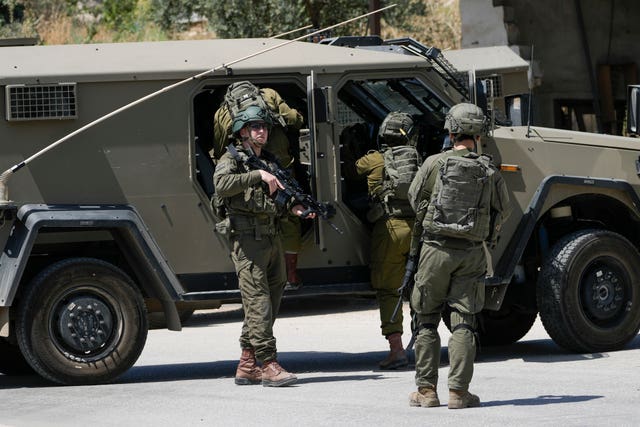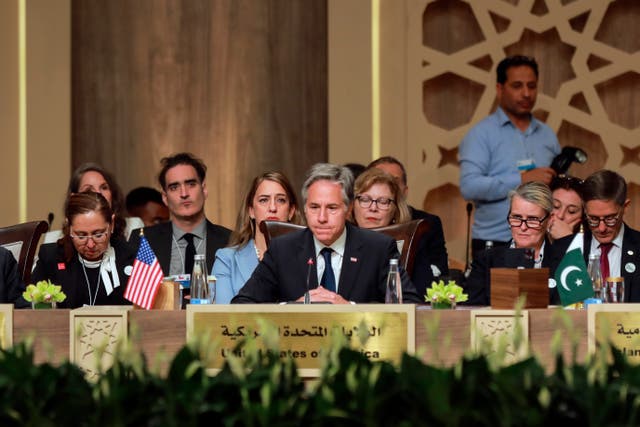Blinken calls on Hamas to accept Gaza ceasefire plan
The UN Security Council has voted overwhelmingly to approve the proposal, with 14 of the 15 members voting in favour and Russia abstaining.

US secretary of state Antony Blinken has said the UN Security Council’s vote in favour of a US-backed proposal for a Gaza ceasefire and hostage release made it “as clear as it possibly could be” that the world supports the plan, as he again called on Hamas to accept it.
“Everyone’s vote is in, except for one vote, and that’s Hamas,” Mr Blinken told reporters in Tel Aviv after meeting Israeli officials.
He said Prime Minister Benjamin Netanyahu had reaffirmed his commitment to the proposal when they met late Monday.
Hamas welcomed US President Joe Biden’s initial announcement of the plan as well as the UN resolution endorsing it but has yet to submit its official response.
“That’s what counts. And that’s what we don’t have yet. And that’s why I say we’re waiting to see it. Everyone has said yes, except for Hamas,” he said.
In a separate development, the UN human rights office said Israeli forces and Palestinian militants may have committed war crimes during the deadly Israeli raid that rescued four hostages over the weekend. At least 274 Palestinians were killed in the operation, according to Gaza’s Health Ministry.

He met privately with families of the hostages as well as demonstrators outside a hotel calling for a ceasefire deal, and later travelled on to Jordan.
Mr Blinken was also expected to visit Qatar, which along with Egypt has served as a key mediator with Hamas. Mr Blinken was in Cairo earlier on Monday.
The proposal, announced by Mr Biden last month, calls for a three-phased plan in which Hamas would release the rest of the hostages in exchange for a lasting ceasefire and the withdrawal of Israeli forces from Gaza. The group is still holding around 120 hostages, a third of whom are believed to be dead.

Hamas supports the broad outline of the agreement but has demanded assurances it will be implemented. The militant group embraced a similar proposal last month that was rejected by Israel.
“Efforts are continuing to study and clarify some matters to ensure implementation by the Israeli side,” Hamas spokesman Jihad Taha said on Tuesday. Israel “has not given clear approval or commitments to implementation that would lead to ending the aggression”, he said.
On Monday, the UN Security Council voted overwhelmingly to approve the proposal, with 14 of the 15 members voting in favour and Russia abstaining. The resolution calls on Israel and Hamas “to fully implement its terms without delay and without condition”.
The proposal has raised hopes of ending an eight-month war that has killed more than 37,000 Palestinians, according to Gaza health officials, and driven some 80% of the population of 2.3 million from their homes.
Israeli restrictions and ongoing fighting have hindered efforts to bring humanitarian aid to the isolated coastal enclave, fuelling widespread hunger.
Later on Tuesday, Mr Blinken attended a Gaza aid conference in Jordan, where he announced more than 400 million dollars in additional aid for Palestinians in Gaza and the wider region.

Mr Biden’s announcement on May 31 of the new proposal said it would begin with an initial six-week ceasefire and the release of some hostages in exchange for Palestinian prisoners. Israeli forces would withdraw from populated areas and Palestinian civilians would be allowed to return to their homes.
Phase one also requires the safe distribution of humanitarian assistance “at scale throughout the Gaza Strip”, which Mr Biden said would lead to 600 trucks with aid entering Gaza every day.
In phase two, the resolution says that with the agreement of Israel and Hamas, “a permanent end to hostilities, in exchange for the release of all other hostages still in Gaza, and a full withdrawal of Israeli forces from Gaza” will take place.
Phase three would launch “a major multi-year reconstruction plan for Gaza and the return of the remains of any deceased hostages still in Gaza to their families”.
The conflicting signals from Mr Netanayahu appear to reflect his political dilemma. His far-right coalition allies have rejected the proposal and have threatened to bring down his government if he ends the war without destroying Hamas.
A lasting ceasefire and the withdrawal of Israeli forces from Gaza would likely allow Hamas to retain control of the territory and rebuild its military capabilities.

The transition from the first to the second phase appears to be a sticking point. Hamas wants assurances that Israel will not resume the war, and Israel wants to ensure that protracted negotiations over the second phase do not prolong the ceasefire indefinitely while leaving hostages in captivity.
Mr Blinken said the proposal would bring an immediate ceasefire and commit the parties to negotiate an enduring one.
“The ceasefire that would take place immediately would remain in place, which is manifestly good for for everyone. And then we’ll have to see,” Mr Blinken said.





